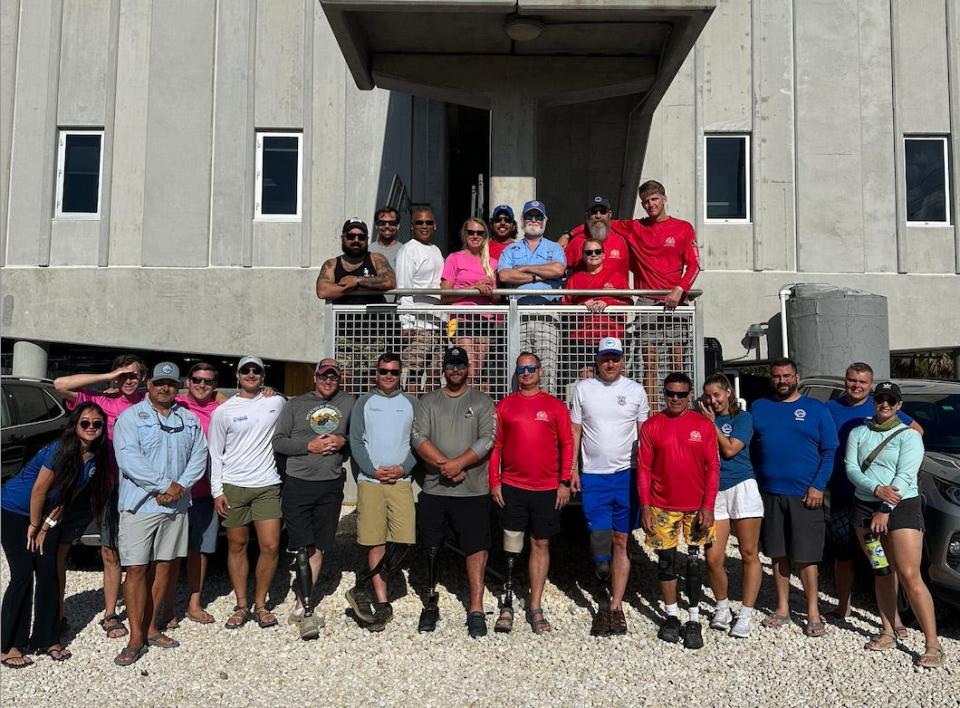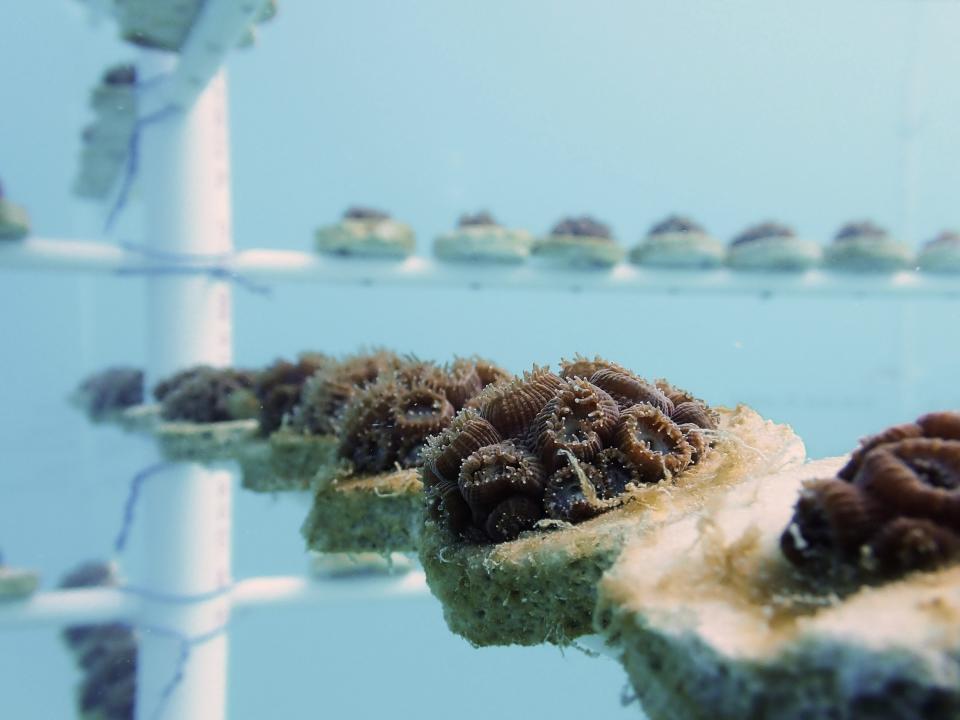Mote partners with combat wounded veterans on novel approach to coral reef restoration
Scientists with Mote Marine Laboratory & Aquarium partnered with 13 veterans affiliated with Combat Wounded Veterans Challenge this month to plant slower-growing boulder corals that provide the framework for a healthy coral reef ecosystem in the Florida Keys.
“Most people when they think of coral they think of those branching corals… the elkhorn, the staghorn, but in point of fact, from an ecological and evolutionary ecological perspective, those branching coral are the species that would come in after the basics of a coral reef has been established through an evolutionary process,” said Mote president & CEO Dr. Michael Crosby.
“With these combat wounded vets, we did focus on outplanting these massive slow growers,” he later added. “We have a high degree of confidence that this could be a huge, major advancement in the whole strategy of coral restoration, where everyone has been focusing – including us – on these fast growing, very beautiful branching corals.”
Mote's 13-year partnership with veterans group
This marked the 13th year that Mote has partnered with the 14-year-old St. Petersburg-based national nonprofit that provides wounded veterans challenging and inspirational ways to reintegrate with civilian life. In turn, data collected while the veterans are on their missions helps medical professionals advance research in everything from traumatic brain injuries and post-traumatic stress to development of orthotics and prosthetics.
Some of the waterproof prosthetics used by the veterans had been developed from research conducted in previous joint missions with Mote and CWVC.

Crosby said this partnership is important to him because his father, uncle and younger brother were career military.
“Now, together, we’re on a mission to help restore and bring back our coral reefs,” Crosby said. “It’s just an amazing partnership when you see their dedication and their perseverance and real positive can-do mission driven attitude.
“It’s so rewarding to be part of that mission with them.”
Mote partnership with CWVC sets a record
The veterans, along with Mote scientists, created 4,538 coral microfragments – including a record 2,003 microfragments in one day – and set 30 new anchors for coral trees in Mote’s coral nursery at Looe Key.
Dr. Jason Spadaro, Mote’s Coral Reef Restoration Research Program Manager, Crosby, and other Mote scientists joined the veterans on the reef to outplant 1,234 corals in one day.
“They’re amazing, incredible guys,” Spadaro said. “Most of them were single or double amputees and they were running circles around us.
“That was probably one of the most productive, impactful and positive partnerships that we’ve had – at last since I’ve been at Mote.”
A larger group from Combat Wounded Veterans Challenge will return to the Elizabeth Moore International Center for Coral Reef Research & Restoration on Summerland Key in June, along with a group of teens enrolled in the Palm Harbor-based SCUBAnauts International marine education program for the ongoing coral restoration.
Underwater heatwave stalls Mission: Iconic Reefs
Mote is one of seven partners working with the National Oceanic and Atmospheric Administration on Mission: Iconic Reefs, a $100 million plan to restore 3 million square feet of coral on seven iconic reefs in the Florida Reef Tract.
The National Oceanic and Atmospheric Administration projects the value of the reef along southeast Florida at $8.5 billion, with more than 70,000 full and part-time jobs generated.
The mission, started in December 2019, suffered a major setback in 2023, when an unprecedented summer heatwave prompted massive coral bleaching.
Staghorn and elkhorn coral were particularly impacted by warm water and subsequent bleaching in a historic climate event that drew international attention after an underwater sensor in Florida Bay recorded a temperature of 101.5 degrees on July 24.
The mission goal is still to increase coral cover at seven sites – the Carysfort Reef Complex and Horseshoe Reef in the upper keys; Cheeca Rocks and Sombrero Key in the middle keys; and Looe Key, Newfound Harbor Patches and Eastern Dry Docks in the lower keys.
A goal of 25% coral cover by the year 2035
Scientists are working to develop corals that will be resilient to warming oceans, ocean acidification – caused by increased levels of carbon dioxide – disease and other factors.
Healthy corals that retain their zooxanthellae algae create calcium carbonate, or limestone, which makes up a coral reef. Coral reefs provide habitat for almost 25% of life in the ocean and protection from storms for homes along the coast.
Once resilient corals are identified, the technique of micro-fragmentation, a process that capitalizes on the natural healing process and allows corals to grow more than 25 times faster than normal – with some larger boulder corals growing up to 50 times faster – can be used to accelerate their growth.
That would increase cover on those sites from an estimated 2% prior to the 2023 bleaching event to 25% by 2035.
Mote is working to restore three additional reefs: American Shoal offshore between Sugarloaf Key and the Saddlebunch Keys; Coffins Patch, a shallow reef southeast of Bamboo Key near Marathon, and Ham Reef off of Islamorada.
Testing a method to build an underwater community
The restoration effort the veterans and SCUBAnauts are assisting on is not technically part of Mission: Iconic Reefs, Spadaro said, but a parallel effort.
“We’re taking kind of an experimental approach where we’re looking at a common garden design, where you have multiple species and multiple genets within those species, all in the same area,” Spadaro said.
Over time, skeletons of dead coral erode. That’s part of the natural life cycle on a living coral reef, too, but without new corals coming in, the reef flattens.
In those “common gardens,” Mote scientists would outplant a variety of corals – branching coral species that provide habitat for fish as well – and monitor the results in comparison to a control plot.
The goal is to determine whether more intense and diverse restoration efforts are slowing the erosion rate, stabilizing the remaining reef structure or increasing the net accretion of calcium caarbonate.
The hope is that the build-up of coral will allow other species to grow, aiming to restore "whole ecosystems rather than just coral populations,” Spadaro said. “And by doing that, are we jump-starting fish communities being more dense and rich in those areas?
“Very soon we’ll be adding herbivores to that equation,” he added, referring to Caribbean King crabs meant to control nuisance algae. “Does that facilitate cascading efforts … so we push the reef over that tipping point and it takes over recovery on its own?”
Preparing for another underwater heatwave
In Late April, NOAA confirmed that the world is currently experiencing its fourth global coral bleaching event and second in the last 10 years.
"From February 2023 to April 2024, significant coral bleaching has been documented in both the Northern and Southern Hemispheres of each major ocean basin," Dr. Derek Manzello, coordinator of NOAA’s Coral Reef Watch, said in a news release.
Coral scientists learned several lessons during the summer of 2023 bleaching event and could conduct an evacuation similar to the one last year.
Crosby noted that Mote has expanded capacity at land-based nurseries to accommodate another 20,000 corals, should another heat-induced bleaching event occur.
“We learned a lot last year – I consider it a successful mission last year – the evacuation and return – putting the corals back in the water but we learned a heck of a lot as well.”
As of late this month, Crosby said water temperatures at some of the reef sites in the Keys are already approaching some of the highest temperatures for this time of year.
Coral bleaching can occur if ocean temperature is higher than the maximum monthly average by as little as 2 to 3 degrees Fahrenheit, or 1 to 2 degrees Celsius,
If ocean temperatures are higher than the maximum monthly average for a month or more, especially during the warmest part of the year, corals will experience bleaching.
“We’re within a half of a degree of the previous high, so the question is, are we going to continue to accelerate?” Crosby said. “Very, very, very importantly, is Florida Bay water going to heat up?”

Florida Bay is where that 101.5 degree temperature reading occurred. Crosby described it as a huge shallow bathtub, where water can evaporate as it gets hot – increasing the salinity and lowering oxygen levels.
That can prompt organisms to die, decompose and reduce the oxygen level even more.
“And when that water goes through those passes out of Florida Bay, that’s an enormous one, two, three punch to the corals,” Crosby said. “We’re hoping we don’t see that but I think we're better prepared to throw all of our resources at an evacuation if it's needed.”
A plan to weather the next underwater heatwave
Should another heat wave occur, vulnerable Acroporid corals – like staghorn and elkhorn corals – would be relocated to Mote's Upper Keys underwater coral nurseries and monitored.
The massive form – boulder, brain and star – coral species will remain in underwater nurseries though if signs of significant thermal stress occurs, they could be moved to among Mote’s four underwater coral nurseries throughout the Florida Keys or brought in to land to ride out the heatwave in one of Mote’s three state-of-the-art land-based coral nursery facilities in the Florida Keys.
Should corals need to be evacuated farther north, Mote expanded the infrastructure at the Mote Aquaculture Research Park in Sarasota and can mobilize more than 50 additional staff and several research vessels – though evacuation of corals outside of the Keys is still considered an extreme measure, since that too can be stressful.
“Pulling them out is very stressful not just on the corals but on the people,” Spadaro said. “So if we can move them up into the nurseries that did very well last year – Key Largo in particular – that moves them out of that thermal stress but with the massive formed corals we’re very confident we can be a little more reactive with those.
“We’re leaving them where they are and prepped to pull them out if we need to.”
This article originally appeared on Sarasota Herald-Tribune: Mote tests new design in effort to restore coral reef in Florida keys

